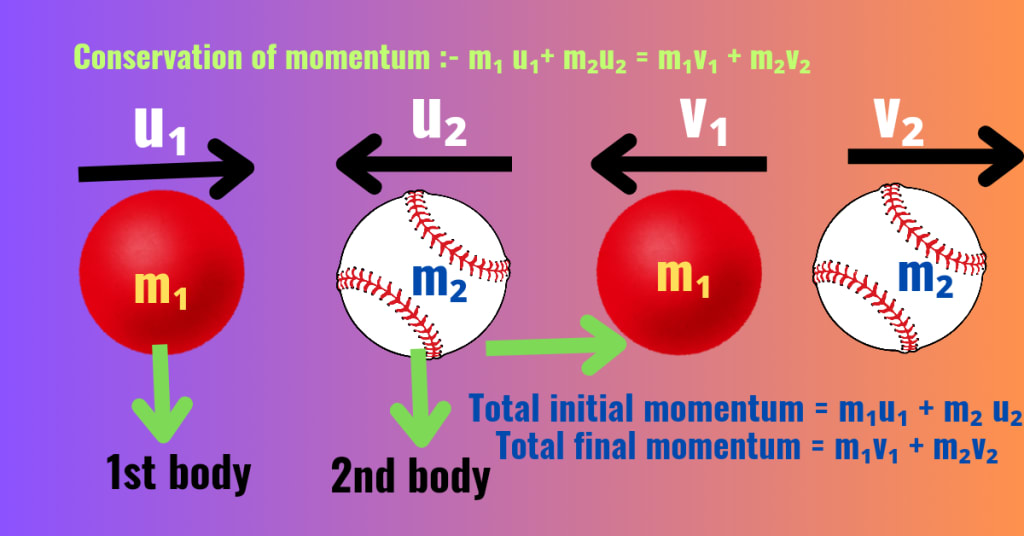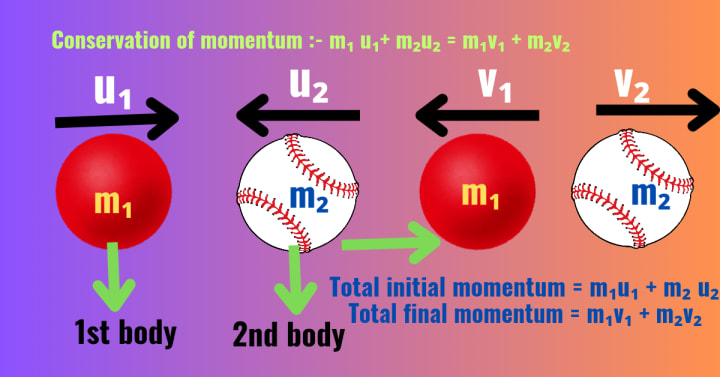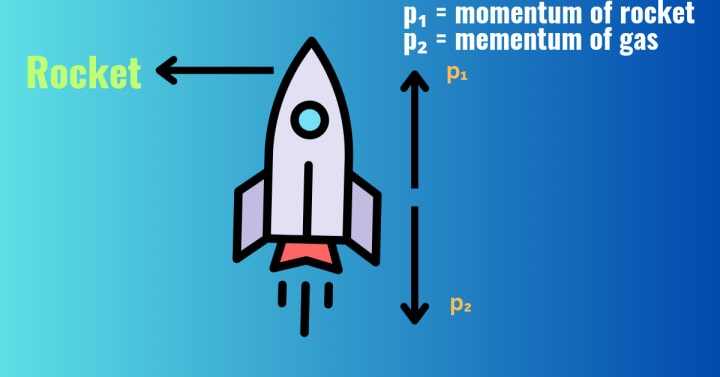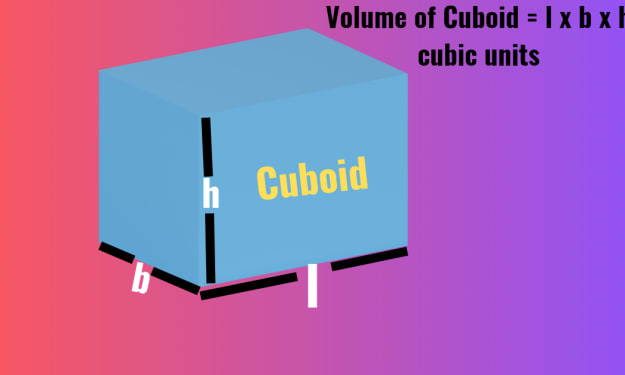
Introduction:
Physics is a fundamental science that seeks to explain the natural phenomena of the universe. Among its many interesting concepts momentum is one of them, which is a principle that plays a crucial role in the study of motion and dynamics. Momentum is a key concept that bridges the understanding of both motion and the forces that affect it. In this article, I will discuss into the concept of momentum,particularly what is momentum class 9 providing a thorough explanation with examples, equations, and real-life applications.
Explanation: To start todays article what is momentum class 9,let us first know
What is Momentum?
Momentum, in its simplest form, is a measure of the quantity of motion an object possesses. It is a vector quantity, meaning it has both magnitude and direction. Mathematically, momentum (p)is defined as the product of an object's mass (m) and its velocity (v) which is written as,
p = m x v
where,p represents momentum,
m is the mass of the object in kilograms (kg), and
v is the velocity of the object in meters per second (m/s).
Historical Background:
The concept of momentum has a rich historical background. It was first introduced by the great scientist Sir Isaac Newton in his second law of motion. Newton's laws of motion, particularly the second law, conveys the foundation for the classical mechanics that we study today. The second law, in essence, describes how the momentum of an object changes with the application of an external force.
Key Characteristics of Momentum:
1.Vector Quantity: Momentum has both magnitude and direction ,So it is a vector quantity. The direction of the momentum vector is the same as the direction of the object's velocity.
2.Dependence on Mass and Velocity: The momentum of a moving body always depends on its mass and its velocity with which it is moving.
The greater the mass and the higher the velocity of an object, the greater its momentum. This implies that a small, fast-moving object can have the same momentum as a large, slow-moving object.
3.Conservation of Momentum: In a closed system where no external forces are acting, the total momentum of the system remains constant. This is known as the conservation of momentum, a fundamental principle in physics.
Calculating Momentum:
To better understand how to calculate momentum, let's consider
Some problems related on momentum:
Question( 1):A car with a mass of 1000 kg is moving at a velocity of 20 m/s. What is its momentum?
Solution: Here,
Mass of the car (m) = 1000 kg
velocity of the car (v) = 20 m/s
∴ Momentum of the car(p) = m x v
= (1000 x 20)
= 20000 kg·m/s
The car's momentum is 20000 kg·m/s in the direction of its velocity.
Question( 2): A moving tennis ball with a mass of 0.05 kg has a momentum 2kg⋅m/s,what is its velocity?
Solution: Here,
Mass of the tennis ball (m) = 0.05 kg
Momentum of the tennis ball(p)= 2kg⋅m/s
∴ Velocity of the tennis ball(v) = p/m
= .05/2
= (.05 x 100) / (2x100)
= 5.00 / 200
= 5 / 200
= 1 / 40
= 0.025 m/sec
Question(3):A moving bike has momentum 1000kg.m/s ,its mass is 200kg; Find is velocity.
Solution: Here,
momentum of the bike(p) = 1000kg.m/s
mass of the bike (m) = 200 kg
Let, velocity of the bike = v m/s
∴ Velocity of the bike(v) = p /m
= 1000 / 200
= 5 kg
The Principle of Conservation of Momentum
One of the most important principles in physics is the conservation of momentum. This principle states that in the absence of external forces, the total momentum of a system remains constant. This can be expressed mathematically as:
Total Initial Momentum=Total Final Momentum

This principle is particularly useful in analyzing collisions and interactions between objects.
Example of Conservation of Momentum:
Let,us Consider two ice skaters pushing off each other. Skater A has a mass of 60 kg and skater B has a mass of 40 kg. If skater a pushes skater B and moves backward at a velocity of 3 m/s, what is the velocity of skater B?
Solution:
Here,
mass of A (m₁)= 60 kg
mass of B(m₂) = 40 kg
Velocity of A (v₁) = - 3 m/s [∵ After strike it moves backward]
Let, the velocity of B = v₂ m/s
As the initial momentum of the system is zero (Since skaters are initially at rest), the total final momentum must also be zero.
𝑚₁×𝑣₁+𝑚₂×𝑣₂=0
=>60 ×(−3 )+40 ×𝑣₂=0
=>-180+40 × v₂ =0
=> 40 x v₂ = 180
=> v₂ = 180 / 40
=> v₂ = 4.5
∴ Skater B will move with a velocity of 4.5 m/s in the opposite direction to skater A.
Types of Collisions
Collisions are events where two or more objects come into contact with each other, and they can be classified based on how momentum and kinetic energy are conserved.
The different types of collisions are:
(i)Elastic Collisions:
In an elastic collision, both momentum and kinetic energy are conserved. This means that the total kinetic energy of the system before and after the collision remains the same. Elastic collisions are often idealized situations, such as collisions between hard, non-deformable objects like billiard balls.
(ii)Inelastic Collisions:
In an inelastic collision, momentum is conserved, but kinetic energy is not. Some of the kinetic energy is converted into other forms of energy, such as heat or sound. A common example of an inelastic collision is a car crash, where the vehicles may deform, and some kinetic energy is lost.
Real-Life Applications of Momentum:
Momentum plays an important role in various real-life scenarios and technological applications. Understanding momentum helps us to design safer vehicles, predict the behavior of celestial bodies, and even perform sports better.
Vehicle Safety:
In car design, engineers use the principles of momentum and impulse (change in momentum) to create safer vehicles. Crumple zones in cars are designed to absorb the impact of a collision, thereby reducing the force experienced by passengers. This is achieved by increasing the time over which the collision occurs, thus reducing the change in momentum and the resulting forces.
Space Exploration:
Momentum is a crucial concept in space exploration. When spacecraft are launched, they rely on the conservation of momentum. For example, when a rocket expels exhaust gases at high velocity, the rocket itself gains momentum in the opposite direction, propelling it into space.
Sports:
Athletes use momentum to enhance their performance. In sports like football, basketball, and cricket, players learn to control and manipulate their momentum to gain an advantage. For instance, a cricketer uses their body’s momentum to bowl the ball faster, while a football player might adjust their momentum to dodge opponents.
Impulse and Momentum:
Impulse is another important concept related to momentum. Impulse is defined as the change in momentum of an object when a force is applied over a period of time. It is given by the equation:
Impulse=Force×Time
Impulse can also be expressed as the change in momentum:
Impulse=Δ𝑝=𝑝final−𝑝initial
where, p = Momentum
Understanding impulse helps in analyzing situations where forces are applied for short durations, such as hitting a ball with a bat or the impact of a hammer on a nail.
Derivation and Relationship Between Force, Mass, and Acceleration:
Newton’s second law of motion provides the relationship between force, mass, and acceleration. It states that the force acting on an object is equal to the rate of change of its momentum. Mathematically, this can be expressed as:
𝐹=𝑑𝑝/𝑑𝑡 , where dp = change in momentum
For constant mass, this equation simplifies to 𝐹=𝑚×𝑎
where, F is the force,m is the mass, and a is the acceleration of the object. This fundamental equation helps us understand how forces cause changes in an object's motion.
Understanding Collisions with Momentum:
To further understand collisions, let's analyze an example involving two objects. Let us,Consider two cars, A and B, involved in a head-on collision. Car A has a mass of 1200 kg and is moving at 15 m/s, while car B has a mass of 800 kg and is moving at 10 m/s in the opposite direction.
What will be final velocity of the combined car?
Solution: Mass of car A (m₁) = 1200kg
Velocity of car A (v₁) = 15 m/s
Before the Collision:
∴Momentum of car A(𝑝𝐴)= m₁ x v₁
= 1200 ×15
=18000 kg⋅m/s
Again,
Mass of car B(m₂) = 800 kg
Velocity of car B (v₂) = −10 m/s [In case of opposite direction]
Momentum of car B(𝑝𝐵) = m₂ x v₂
=800 ×(−10 )
=−8000 kg⋅m/s
Now,Total initial momentum = 𝑝total, initial=𝑝𝐴+𝑝𝐵
=18000 +(−8000 )
=10000 kg⋅m/s
After the Collision:
Assuming that the collision is perfectly inelastic (the cars stick together after the collision),
∴The total mass of the combined cars =
=𝑚total
=1200 +800
=2000 kg
Using the conservation of momentum:
𝑝total, Initial=𝑚total×𝑣final
=>10000 =2000 ×𝑣final
=>𝑣final=10000 /2000
=>vfinal = 5
∴𝑣final=5 m/s
The final velocity of the combined cars after the collision is 5 m/s in the direction of car A’s original motion.
The Role of Momentum in Rockets and Space Travel:

Momentum plays a crucial role in rocketry and space travel. Rockets operate based on the principle of conservation of momentum. When a rocket expels exhaust gases at high speeds, it gains an equal and opposite momentum, propelling it forward. This is an application of Newton’s third law of motion: for every action, there is an equal and opposite reaction.
Let us explain this with an example.
Example:
Let us Consider a rocket with a mass of 500 kg. If it expels 10 kg of exhaust gases at a velocity of 200 m/s, what is the velocity of the rocket?
Solution: Here,
Mass of rocket (m₁) = 500 kg
Mass of gases (m₂) = 10kg
velocity of gases (v₂) = 200 m/s
Let, velocity of the rocket = v₁
About the Creator
Enjoyed the story? Support the Creator.
Subscribe for free to receive all their stories in your feed. You could also pledge your support or give them a one-off tip, letting them know you appreciate their work.





Comments
There are no comments for this story
Be the first to respond and start the conversation.